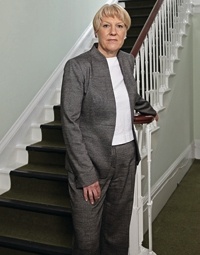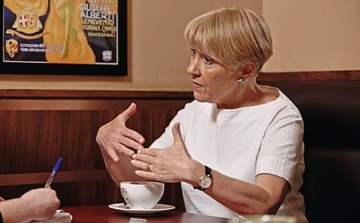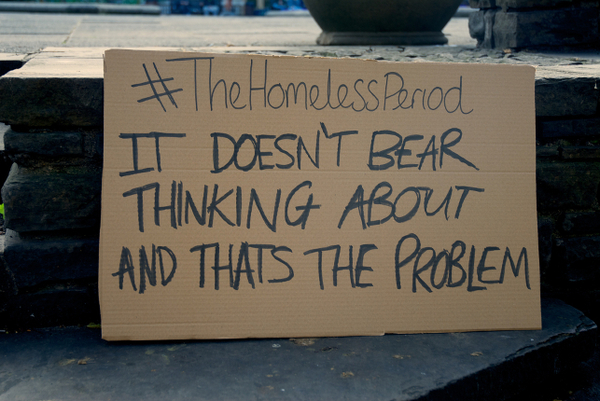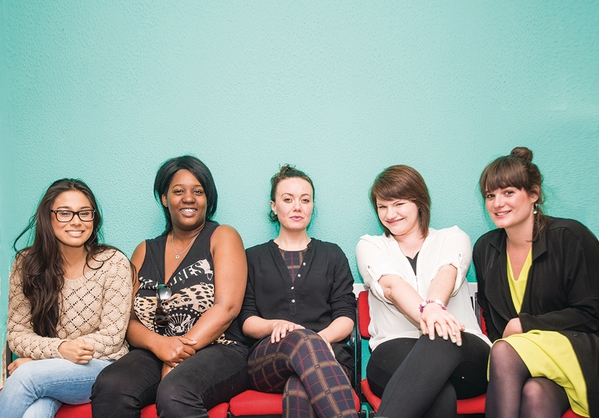You are viewing 1 of your 1 free articles
Are women-only landlords still necessary?
Eighty years on from the founding of Housing for Women, is gender-specific provision as necessary as it once was? Kate Youde asks its current chief executive
When, 80 years ago, a group of concerned Londoners set out to help unemployed ‘older women’ find work, they soon realised the women also needed secure, affordable homes. And so, the Over Thirty Association opened its first hostel three years later, in 1937, to provide temporary accommodation for unemployed and homeless women.
Today, Housing for Women, as the housing association became known in 1992, houses women in nearly 900 homes across eight London boroughs. One of only a handful of women-focused associations in the country, Inside Housing has come to meet Jakki Moxham, its chief executive, to find out if a gender-specific service is still needed in 2014.
Unsurprisingly, Ms Moxham, who is approaching the end of her first year as chief executive when we meet, says it ‘absolutely is’. The issues that were really important when the organisation was founded in 1934 remain so, she says: women are still paid less than men and are doing lower-paid work.
About 25 per cent of the organisation’s residents are women over the age of 60, many of who are ‘still bearing the brunt of discrimination earlier in their careers in that their pensions are pitiful,’ she points out. Ms Moxham is friendly, chatty and keen to answer questions, her white top accentuating the tan she has gained while tending the fruit bushes in her garden in Bow, east London. The only one she dodges is that of her age - something I suppose I am not supposed to ask a woman.
A long legacy
We meet outside ‘Mouse Castle’, a four-storey property in the upmarket Campden Hill Square in Kensington and Chelsea, named Britain’s most expensive residential street in 2011. The building earned its nickname because it was used to house hunger-striking suffragettes following their release from prison under the Cat and Mouse Act.

Source: Tom Campbell
Officially known as the 1913 Prisoners (Temporary Discharge for Ill-Health) Act, the legislation allowed suffragettes to be released from prison early if they were so weakened by their refusal to eat that they were at risk of death. Once they had recuperated, they were recalled to prison and the process started afresh.
Many of the association’s early supporters were suffragette sympathisers. The former home of the artist Georgina Brackenbury, whose painting of Emmeline Pankhurst hangs in the National Portrait Gallery, ‘Mouse Castle’ was bequeathed to the association in 1951 and now provides nine flats for social rent in a sought-after part of the capital. Given that American suffragist Susan B Anthony once famously called women on bicycles ‘the picture of free, untrammeled womanhood’, it seems in keeping with the organisation’s history that Ms Moxham is carrying an overnight bag ready for a trip to Dorset on the back of a motorbike.
Housing for Women carries on in the footsteps of these early women’s rights campaigners in more fundamental ways too, working with some of the most marginalised groups in the UK, such as trafficked women and women leaving prison. Ms Moxham hopes to use her tenure in the top job to expand its reach in these areas. As well as providing about 840 general needs homes - all tenancies are in women’s names, although there are men living in some families in keeping with Housing for Women’s founding objectives - the association runs specialised services for women. For those fleeing domestic violence, it provides refuges in Greenwich and Ealing and a helpline in Greenwich, where it also works in police stations to provide advice and information to women who report abuse.
Its Re-Unite South London project reunites women coming out of jail with their children at the prison gate and helps them to re-establish those relationships, deal with any custody issues and put long-term family arrangements in place. Re-offending is at 2.9 per cent as a result of the scheme, Housing for Women claims, compared with the national average of over 50 per cent for women. Typically, at any one time, the project helps about a dozen women, who stay for up to nine months in 10 properties leased for the project.
‘When a woman comes out of prison, she’s intentionally homeless because, of course, she’s committed the crime and also for lots of reasons she can’t go back to wherever it was that she came from,’ Ms Moxham tells me, sipping on a cappuccino after we move from ‘Mouse Castle’ to a nearby coffee shop.
‘While she’s got her children with her and she can establish herself as a family, she can start to get priority for housing so she can then be accepted on to the waiting list. She might go into temporary accommodation, she might go into social [housing], she might go into the private sector, but she’s got more stability. Our work in that period is about re-establishing the family unit.’
The scheme is currently funded through charitable sources but the association is hoping to expand its reach. It is part of a consortium - yet to be formally announced - looking to bid under a prime contractor for services to women offenders.
Another Housing for Women project, Re-Place, relies on around £220,000 a year in charitable funds to provide self-contained housing and support to women trafficked for prostitution or domestic servitude, who have no recourse to public funds, once their 45 days in a government-funded safe house have come to an end. Most of the women are suffering from post-traumatic stress disorder, mental health issues and, in many cases, physical health problems as well.
Vital support
The programme, the only ‘second stage’ project of its kind in London, helps women to improve their English, access healthcare, deal with the police and immigration authorities, and get onto training courses or find a job. ‘Really it’s a drop in the ocean,’ says Ms Moxham, of the scale of the assistance that Re-Place is able to provide. According to the National Crime Agency, there were 562 referrals of potential victims of trafficking between October and December 2013. However, the agency stresses that the number of referrals is not a measure of human trafficking in the UK.
The association plans to use charitable funds to extend its service by providing floating support to more trafficking victims, not just those it houses, adds Ms Moxham, including within the ‘absolutely awful’ government mixed-sex asylum seeker accommodation, which is the alternative for victims. As part of its submission of evidence to the draft Modern Slavery Bill currently being considered by parliament, Housing for Women called for an extension to the 45-day reflection and recovery period - to at least 90 days - and for the provision for victims to be enshrined in legislation.
Attracted to Housing for Women because it ‘does what it says on the tin’ and the important role of the organisation, Ms Moxham joined in June last year from a four-month stint as interim chief executive at the drug and alcohol charity Foundation 66. Learning about the association’s specialist schemes was a challenge, she recalls. ‘The amount of need and the sheer lack of provision was really quite a shock.’ However, the chief executive is by no means new to the challenges of housing, having worked in the sector for decades.
Raised in a ‘socially-minded home’ in Manchester, she first became interested in housing while studying social policy at Durham University. After work placements in housing at Birmingham Council in the late 1970s, her first job was at the housing association now known as Midland Heart and she has gone on to hold senior roles at organisations including the 19,300-home Network Housing.
Complete dedication
Ms Moxham is on the board of Peter Bedford Housing Association, which has 260 supporting housing units in London, and Clare Norton, its chief executive, says she not only ‘really knows her stuff’ but is also passionate about the association’s work. ‘She’s got really good skills in terms of being a critical friend to Peter Bedford but… doing that in an engaging way that’s easy to work with,’ adds Ms Norton.
‘I’ve always been motivated by the concept that a decent home is a springboard to a decent life,’ says Ms Moxham. ‘When I was young, the way I would talk about it was if you had a decent home you could do your homework so you could do better at school. If it wasn’t damp, your health would be better; you’d have somewhere stable to go home to after you’d been at work. That is still what motivates me.’

Source: Tom Campbell
When it comes to Housing for Women’s specific mission, she adds, women are disproportionate sufferers of the housing shortage in London because their lower wages make it harder for them to afford the rents. Housing for Women’s biggest challenge is finding the money to build more homes.
Like many chief executives of less specialist housing associations, she would like to see a return of social housing grant, at levels that allow rents to remain affordable without cross subsidy. ‘In other words, it’s much better to keep the costs down and the rents down than it is to push the rents up and then have to pay them through housing benefit,’ she says.
Aside from hoping for a change in government policy, Housing for Women is also thinking about if it should sell its high-value property to raise money for more homes. ‘But we have to balance that with our social purpose which is to provide homes for lower income women and these [central London] locations are ideal really,’ points out Ms Moxham, because they are close to jobs.
In the meantime, it plans to provide eight social rented homes with a capital grant from the Tudor Trust, as part of Older Women’s Co-housing, which will also see 17 owner-occupiers buy flats in a purpose-built block in Barnet.
A brighter future
Housing is going to be a ‘hot potato’ in the next election, Ms Moxham anticipates, as the shortage of supply and its impact on rent levels affects families.
However, she says there is still a failure among politicians to recognise overall government policies affect women more than men. ‘I think there is a failure to recognise that a lot of the welfare reforms and changes in the economy impact more strongly on women, so things like the rising cost of childcare, which is tremendously unaffordable are working against the initiatives that we are taking part in and other people are running to help women get back into work,’ she says.
So the need for a housing association dedicated to women is still evident today - but what of its future?
‘I don’t think anybody could deny that there have been great steps forward in the past 80 years, but I think that we will be here in another 80 years’ time,’ Ms Moxham predicts. ‘I think there will still be a need, there will still be people for whom this is the most appropriate type of accommodation and there will be gender specific services that are really valued.’
Career in brief
2013 to present
Chief executive: Housing for Women
2013 - 2013
Interim chief executive: Foundation 66
2010 - 12
Group director of corporate services: Network Housing Group
2005 - 10
Group director of operations: Network Housing Group
2004 - 05
Interim chief executive: Hillside Housing Trust
2003 - 04
Interim chief executive: Central Walsall Housing Trust
1999 - 03
Managing director north: English Churches Housing Group
Early career:
After starting out at Midland Heart as a housing officer collecting rent, reporting repairs and decanting tenants, Ms Moxham became the only employee of Tangram Housing Co-op in Leeds. She also undertook development work for Richmond Fellowship, a specialist provider of mental health services.
Organisations for women
Housing for Women is not the only housing association which specifically aims to house women - but there aren’t many.
Another similar organisation is Women’s Pioneer Housing, established in 1920 to help working women in the years after the first world war, who often struggled to find affordable housing. Landlords were often hostile to the idea of renting to single women, the organisation says, and women who continued to work after the war were seen as stealing men’s jobs.
The organisation was funded by selling shares to investors for a low return. The money was used to buy and convert houses for women to live in. Later, the organisation built its own homes, designed by Britain’s first female architect, Gertrude Leverkus.
Today the organisation has 1,000 homes, all in west London, and is gradually adding to its stock through a ‘hidden homes’ programme, which involves converting under-utilised areas in its existing buildings.
Janet Davies, chief executive of Pioneer Women’s Housing, explains that the tenancy of 1,000 homes is always given to the woman in the household. That way, she explains, ‘the woman always has control of her home’.
Although it seems unlikely that many new housing associations will be added to the small list of those focusing on housing women, a new social enterprise called Rooms of Our Own launched recently. With the MP Stella Creasy as a patron, the feminist organisation is planning a multi-purpose building in Walthamstow, which will combine housing with commercial spaces for businesses run by women, charities and activist groups needing spaces to meet in the capital.










